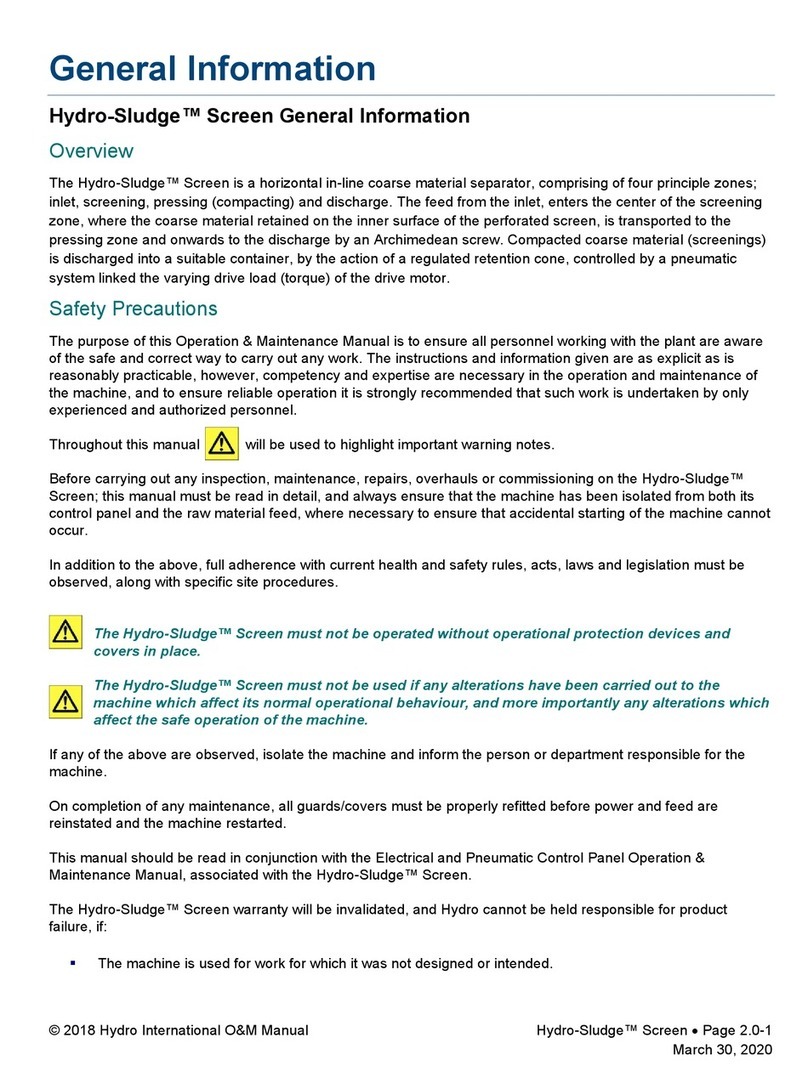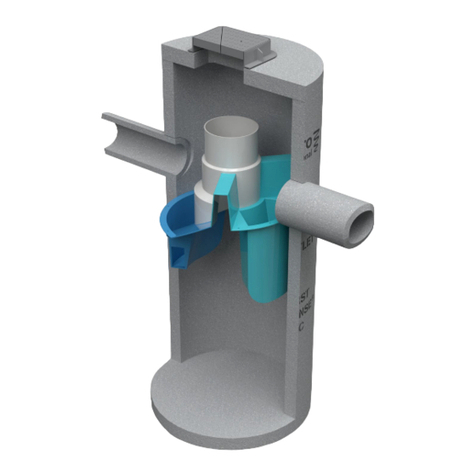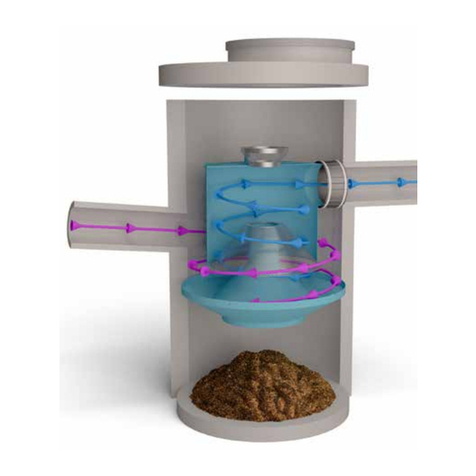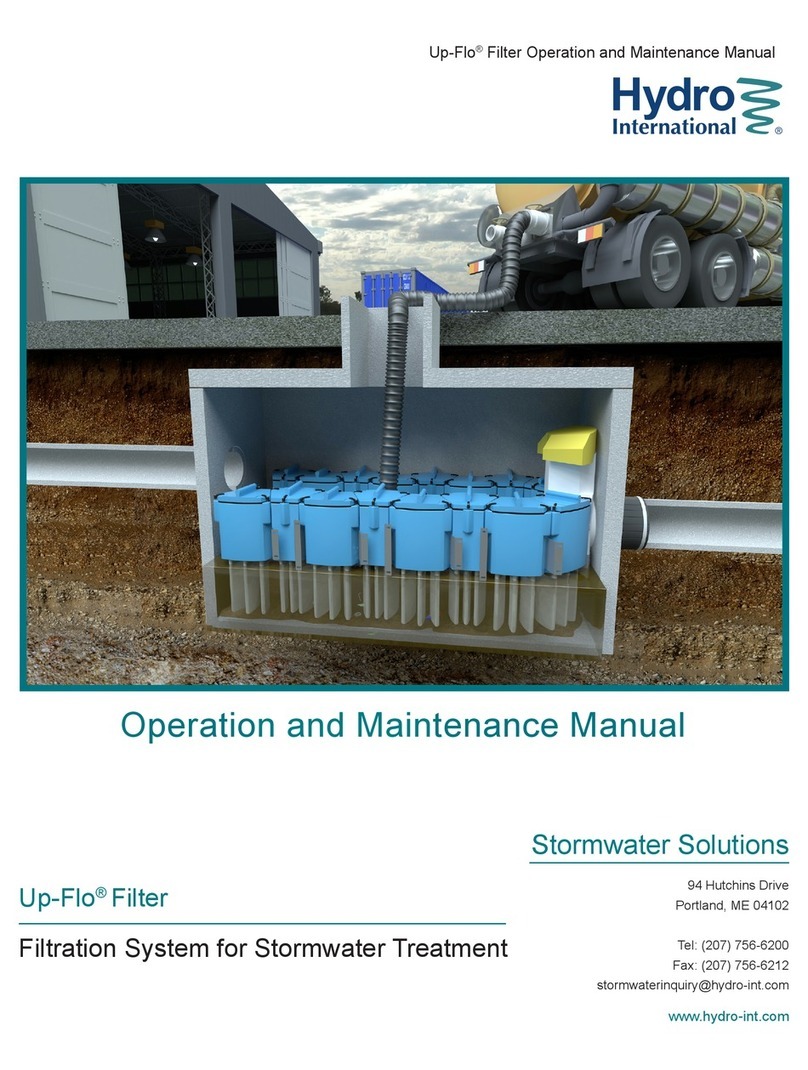
Up-Flo®Filter Operation and Maintenance Manual
Hydro International (Stormwater), 94 Hutchins Drive, Portland ME 04102
Tel: (207) 756-6200 Fax: (207) 756-6212 Web: www.hydro-int.com
Maintenance Procedures Not Requiring Man Entry:
Floatables, Oil and Sediment Clean Out
1. Set up any necessary safety equipment (such as traf-
c cones) around the access of the Up-Flo®Filter. Safety
equipmentshouldnotifypassingpedestrianandroadtrafc
that work is being done.
2. Remove the grate or lid to the manhole or vault.
3. Without entering the vessel, look down into the chamber to
inspect the inside. Make note of any irregularities.
4. If the standing water level in the sump is above the base of
theFilter Modules(seeFig.8),tugthePullChain(s) tore-
lease the Drain Down Filter plug(s). Allow the excess water
to drain out of the chamber.
5. Use the skimmerpoletottheDrainDownFilterplugback
into the open port.
6.Once all oatables and oil have been removed, drop the
vactor hose to the base of the sump. Vactor out the sedi-
mentandgrossdebrisfromthesumpoor.Upto0.3yd3
(0.2 m3) of sediment and 360 gallons (1,363 L) of water will
be removed from a typical manhole Up-Flo®Filter during
this process.
7. Retract the vactor hose from the vessel.
8.InspecttheAngledScreensforblockagesandragging.If
present, remove the obstruction or ragging materials from
the surface using a hose or other screen-cleaning device.
9. On the Maintenance Log provided by Hydro International,
record the date, unit location, estimated volume of oata-
bles, oils, and gross debris removed, and the depth of sedi-
ment measured. Note any apparent irregularities such as
damaged components or blockages.
10. Securely replace the grate or lid. Remove safety equip-
ment.
11. Dispose of sediment and gross debris following local regula-
tions.
12. Dispose of oil and sump water at a licensed water treatment
facility or following local regulations.
13. Contact Hydro International at (800) 848-2706 to discuss
any irregularities noted during cleanout.
Maintenance Activities Requiring Man Entry
These activities include replacement of the Media Packs and
Drain Down Filter.
Unless the Up-Flo®Filter has been installed as a very shal-
lowunit,itisnecessarytohaveanOSHA-connedspaceentry
trained person enter the vessel to replace Media Packs.
The access port located at the top of the manhole or vault pro-
vides access to the Up-Flo®vessel for maintenance personnel
to enter the vessel and remove and replace Media Packs. The
same access would be used for maintenance personnel working
fromthesurfacetonetorskimdebrisandoatablesortovactor
out sediment, oil, and water. Unless the Up-Flo®Filter has been
installedinaveryshallowconguration,itisnecessarytohave
personnelwithOSHAConnedSpaceEntrytrainingperforming
the maintenance that occurs inside the vessel.
Scheduling
• Call Hydro International to order replacement Media Packs
and Drain Down Filter prior to scheduling maintenance.
• Because Media Pack replacement requires entry into the
Up-Flo®chamber, maintenance events should be scheduled
during dry weather.
• Media Pack replacement should occur immediately after a
contaminated spill in the contributing drainage area.
7
Page | 10
Fig.8 Cutaway view of the Filter Module































